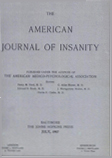ELECTROENCEPHALOGRAPHIC STUDIES OF CORTICOHYPOTHALAMIC RELATIONS IN SCHIZOPHRENIA
Abstract
Using hypothalamic and cortical leads electroencephalographic studies in schizophrenics give the following preliminary results.
1. Reaction to external cold is deficient in that no reactive hyperthermia results and little electrical activity in hypothalamus or cortex can be observed. The normal or neurotic shows a definite reaction in both leads.
2. Adrenalin injected intravenously causes violent subjective and objective reactions but intramuscularly causes little subjective and usually no objective effect on hypothalamus or cortex in schizophrenics. The intramuscular injection, however, causes a prompt and striking effect in normals and neurotics electrically as well as subjectively demonstrable.
3. Electrical stimulation of the hypothalamus of schizophrenics caused minimal or no reaction in that structure demonstrable by the EEG or secondarily in the cortex. Normal and neurotics showed a profound excitation of hypothalamus and cortex, frequently with prolonged "condensor" effect, and usually subjective responses as well.
4. Verbal stimuli when applied to schizophrenics elicited no excitation in either lead whereas excitability from both has been recorded in neurotic subjects.
5. Sodium amytal injected intravenously showed a typical hypothalamic and cortical response, more striking in the hypothalamus, which further study may correlate with the "amytal interview" effect, and be related to the selective action of barbiturates.
6. Speculations have been presented regarding the fundamental deficiency of dynamic action of the hypothalamus in schizophrenia and its possible secondary effects in the production of the essential psychosis in the psychomotor system.
Access content
To read the fulltext, please use one of the options below to sign in or purchase access.- Personal login
- Institutional Login
- Sign in via OpenAthens
- Register for access
-
Please login/register if you wish to pair your device and check access availability.
Not a subscriber?
PsychiatryOnline subscription options offer access to the DSM-5 library, books, journals, CME, and patient resources. This all-in-one virtual library provides psychiatrists and mental health professionals with key resources for diagnosis, treatment, research, and professional development.
Need more help? PsychiatryOnline Customer Service may be reached by emailing [email protected] or by calling 800-368-5777 (in the U.S.) or 703-907-7322 (outside the U.S.).



